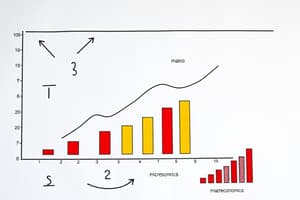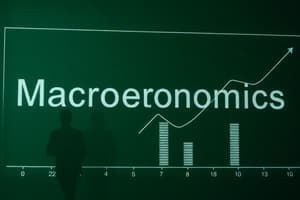Podcast
Questions and Answers
What is the primary focus of microeconomics?
What is the primary focus of microeconomics?
Microeconomics focuses on individual agents, such as households and firms, and their interactions in markets.
Explain the concept of scarcity in economics.
Explain the concept of scarcity in economics.
Scarcity refers to the limited nature of resources which necessitates choices and trade-offs in resource allocation.
What is opportunity cost?
What is opportunity cost?
Opportunity cost is the value of the next best alternative that is foregone when a choice is made.
Describe the market structure of a monopoly.
Describe the market structure of a monopoly.
What does GDP stand for and what does it represent?
What does GDP stand for and what does it represent?
What is the primary goal of fiscal policy?
What is the primary goal of fiscal policy?
Define comparative advantage in international trade.
Define comparative advantage in international trade.
What does supply-side economics focus on?
What does supply-side economics focus on?
Flashcards are hidden until you start studying
Study Notes
Key Concepts in Economics
Basic Definitions
- Economics: The study of how individuals and societies allocate limited resources to satisfy unlimited wants.
- Microeconomics: Focuses on individual agents, such as households and firms, and their interactions in markets.
- Macroeconomics: Studies aggregate economic phenomena, such as inflation, unemployment, and economic growth.
Fundamental Principles
- Scarcity: Resources are limited, necessitating choices and trade-offs.
- Supply and Demand:
- Law of Demand: As prices fall, quantity demanded rises, and vice versa.
- Law of Supply: As prices rise, quantity supplied rises, and vice versa.
- Opportunity Cost: The value of the next best alternative foregone when a choice is made.
- Incentives: Factors that motivate individuals to make economic decisions.
Market Structures
- Perfect Competition: Many firms, identical products, no barriers to entry.
- Monopoly: Single firm dominates the market, unique product, high barriers to entry.
- Oligopoly: Few firms control the market, products may be identical or differentiated.
- Monopolistic Competition: Many firms, differentiated products, low barriers to entry.
Economic Indicators
- Gross Domestic Product (GDP): Total value of all goods and services produced within a country.
- Unemployment Rate: Percentage of the labor force that is unemployed and actively seeking work.
- Inflation Rate: The rate at which the general level of prices for goods and services rises.
Government and Economics
- Fiscal Policy: Government adjustments in spending and taxation to influence the economy.
- Monetary Policy: Central bank actions that manage the money supply and interest rates.
- Regulation: Rules established by authorities to control economic activities.
Economic Theories
- Classical Economics: Emphasizes free markets, limited government intervention.
- Keynesian Economics: Argues for increased government expenditures and lower taxes to stimulate demand.
- Supply-Side Economics: Focuses on boosting economic growth by increasing supply (production) rather than demand.
International Economics
- Trade: Exchange of goods and services between countries.
- Comparative Advantage: A country’s ability to produce a good at a lower opportunity cost than another.
- Exchange Rates: The value of one currency for the purpose of conversion to another.
Current Economic Issues
- Income Inequality: Disparity in wealth distribution among individuals.
- Globalization: Economic integration and interdependence among countries.
- Sustainability: Economic development that meets present needs without compromising future generations.
These notes encapsulate the foundational aspects of economics, providing a framework for understanding both individual and systemic economic behavior.
Basic Definitions
- Economics: Focuses on allocation of limited resources to meet unlimited wants.
- Microeconomics: Examines individual entities like households and firms, especially their market interactions.
- Macroeconomics: Investigates broader economic issues such as inflation, unemployment, and overall economic growth.
Fundamental Principles
- Scarcity: Limited resources necessitate choices and trade-offs among alternatives.
- Supply and Demand:
- Law of Demand: Price decrease leads to a rise in quantity demanded.
- Law of Supply: Price increase incentivizes a rise in quantity supplied.
- Opportunity Cost: Represents the value of the best alternative sacrificed when making a choice.
- Incentives: Factors that influence and motivate economic decision-making.
Market Structures
- Perfect Competition: Characterized by many firms producing identical products, no market-entry barriers.
- Monopoly: Single firm dominates the market with a unique product, facing high entry barriers.
- Oligopoly: Market controlled by a few firms, which may offer identical or varied products.
- Monopolistic Competition: Features many firms providing differentiated products with low barriers to market entry.
Economic Indicators
- Gross Domestic Product (GDP): Total monetary value of all goods and services produced in a country within a specific time frame.
- Unemployment Rate: Indication of the percentage of the labor force that is jobless and actively seeking employment.
- Inflation Rate: Measures the rate of increase in the general price level of goods and services.
Government and Economics
- Fiscal Policy: Involves government actions related to spending and taxation aimed at economic influence.
- Monetary Policy: Central bank strategies focused on managing the money supply and adjusting interest rates.
- Regulation: Established guidelines by authorities to oversee and control economic activities.
Economic Theories
- Classical Economics: Advocates for minimal government intervention and the efficiency of free markets.
- Keynesian Economics: Supports government fiscal interventions—like increased spending and reduced taxes—to boost economic activity.
- Supply-Side Economics: Prioritizes economic growth by focusing on enhancing production capabilities over increasing demand.
International Economics
- Trade: Involves the international exchange of goods and services between nations.
- Comparative Advantage: Highlights a country's ability to produce certain goods at a lower opportunity cost, promoting efficient trade.
- Exchange Rates: Defines the value relationship between one currency and another, impacting international trade and finance.
Current Economic Issues
- Income Inequality: Refers to the uneven distribution of wealth and economic resources within a population.
- Globalization: Describes the process of economic integration and the interconnectedness of global markets.
- Sustainability: Focuses on developing economic systems that fulfill current needs while safeguarding resources for future generations.
Studying That Suits You
Use AI to generate personalized quizzes and flashcards to suit your learning preferences.




